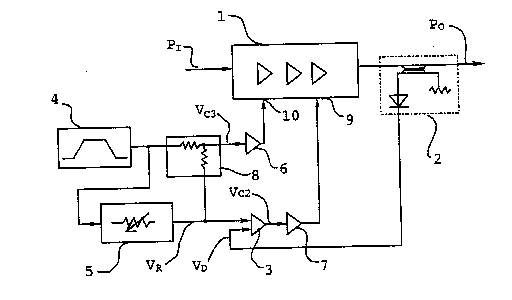Some of the information on this Web page has been provided by external sources. The Government of Canada is not responsible for the accuracy, reliability or currency of the information supplied by external sources. Users wishing to rely upon this information should consult directly with the source of the information. Content provided by external sources is not subject to official languages, privacy and accessibility requirements.
Any discrepancies in the text and image of the Claims and Abstract are due to differing posting times. Text of the Claims and Abstract are posted:
| (12) Patent: | (11) CA 2080450 |
|---|---|
| (54) English Title: | BURST CONTROL CIRCUIT FOR USE IN TDMA COMMUNICATIONS SYSTEM |
| (54) French Title: | CIRCUIT DE COMMANDE DE SALVES POUR SYSTEME DE COMMUNICATION AMRT |
| Status: | Expired and beyond the Period of Reversal |
| (51) International Patent Classification (IPC): |
|
|---|---|
| (72) Inventors : |
|
| (73) Owners : |
|
| (71) Applicants : |
|
| (74) Agent: | G. RONALD BELL & ASSOCIATES |
| (74) Associate agent: | |
| (45) Issued: | 1998-08-11 |
| (22) Filed Date: | 1992-10-13 |
| (41) Open to Public Inspection: | 1993-04-15 |
| Examination requested: | 1992-10-13 |
| Availability of licence: | N/A |
| Dedicated to the Public: | N/A |
| (25) Language of filing: | English |
| Patent Cooperation Treaty (PCT): | No |
|---|
| (30) Application Priority Data: | ||||||
|---|---|---|---|---|---|---|
|
A burst control circuit for use in a TDMA communications system
comprises a power amplifier having two separate control terminals.
A level control signal which is the difference between a reference
signal and the level of the output burst signal of the amplifier,
feedback-controls the level of the output burst signal through
first control terminal, and a waveform control signal having
predetermined waveform, controls the waveform of the output burst
signal through a second control terminal. When the level of the
reference signal is decreased, the amplitude of the waveform
control signal is decreased as a function of the level of the
reference signal.
L'invention est un circuit de contrôle de salves pour système de communication AMRT qui comprend un amplificateur de puissance ayant deux bornes de contrôle distinctes. Un signal de contrôle de niveau, qui est constitué de la différence entre un signal de référence et le niveau du signal de salve de sortie de l'amplificateur, contrôle par rétroaction le niveau du signal de salve de sortie par l'intermédiaire de la première borne de contrôle, et un signal de contrôle de forme d'onde ayant une forme d'onde prédéterminée contrôle la forme d'onde du signal de salve de sortie par l'intermédiaire de la seconde borne de contrôle. Quand le niveau du signal de référence baisse, l'amplitude du signal de contrôle de forme d'onde baisse en fonction de ce niveau.
Note: Claims are shown in the official language in which they were submitted.
Note: Descriptions are shown in the official language in which they were submitted.

2024-08-01:As part of the Next Generation Patents (NGP) transition, the Canadian Patents Database (CPD) now contains a more detailed Event History, which replicates the Event Log of our new back-office solution.
Please note that "Inactive:" events refers to events no longer in use in our new back-office solution.
For a clearer understanding of the status of the application/patent presented on this page, the site Disclaimer , as well as the definitions for Patent , Event History , Maintenance Fee and Payment History should be consulted.
| Description | Date |
|---|---|
| Inactive: IPC from MCD | 2006-03-11 |
| Time Limit for Reversal Expired | 2002-10-15 |
| Letter Sent | 2001-10-15 |
| Grant by Issuance | 1998-08-11 |
| Pre-grant | 1998-04-16 |
| Inactive: Final fee received | 1998-04-16 |
| Inactive: Correspondence - Prosecution | 1997-10-29 |
| Notice of Allowance is Issued | 1997-10-24 |
| Notice of Allowance is Issued | 1997-10-24 |
| Letter Sent | 1997-10-24 |
| Inactive: Status info is complete as of Log entry date | 1997-10-20 |
| Inactive: Application prosecuted on TS as of Log entry date | 1997-10-20 |
| Inactive: IPC removed | 1997-09-25 |
| Inactive: First IPC assigned | 1997-09-25 |
| Inactive: IPC assigned | 1997-09-25 |
| Inactive: IPC assigned | 1997-09-25 |
| Inactive: Approved for allowance (AFA) | 1997-09-22 |
| Application Published (Open to Public Inspection) | 1993-04-15 |
| Request for Examination Requirements Determined Compliant | 1992-10-13 |
| All Requirements for Examination Determined Compliant | 1992-10-13 |
There is no abandonment history.
The last payment was received on 1997-10-03
Note : If the full payment has not been received on or before the date indicated, a further fee may be required which may be one of the following
Patent fees are adjusted on the 1st of January every year. The amounts above are the current amounts if received by December 31 of the current year.
Please refer to the CIPO
Patent Fees
web page to see all current fee amounts.
| Fee Type | Anniversary Year | Due Date | Paid Date |
|---|---|---|---|
| MF (application, 5th anniv.) - standard | 05 | 1997-10-14 | 1997-10-03 |
| Final fee - standard | 1998-04-16 | ||
| MF (patent, 6th anniv.) - standard | 1998-10-13 | 1998-10-05 | |
| MF (patent, 7th anniv.) - standard | 1999-10-13 | 1999-09-17 | |
| MF (patent, 8th anniv.) - standard | 2000-10-13 | 2000-09-25 |
Note: Records showing the ownership history in alphabetical order.
| Current Owners on Record |
|---|
| NEC CORPORATION |
| Past Owners on Record |
|---|
| DAIJI HORIKOSHI |
| KAZUYA HASHIMOTO |